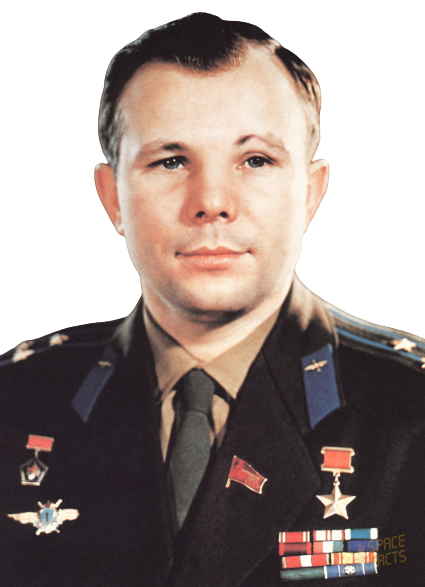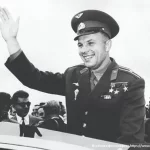
18.12.2022
The USSR pilot-cosmonaut, Hero of the Soviet Union
Date and place of birth:
The first man to fly into space, the USSR pilot-cosmonaut Yuri Alexeyevich Gagarin was born on March 9, 1934 in the village of Klushino, Gzhatsky (now Gagarinsky) district of Smolensk region. His parents – Aleksey Ivanovich and Anna Timofeevna Gagarin were hereditary Smolensk peasants, collective farmers.
Date and cause of death:
On March 27, 1968, he was killed in an airplane crash on a UTI MiG-15 plane along with test pilot Colonel V.S. Seregin during a training flight. The plane crashed near the village of Novoselovo, Kirzhach district of Vladimir region. The exact cause of the crash has not been determined.
He is buried in the Kremlin Wall on Red Square in Moscow.
Education:
1941 – entered the 1st grade of secondary school in the village of. Klushino, but his studies were interrupted by the war. Only in 1943 he resumed studies at the school.
Between 1945-1949 he studied (completed 6 classes). – Between 1945 and 1949 he studied (sixth grade) at a secondary school in Gzhatsk (in 1945 the Gagarins’ family moved to Gzhatsk).
From 1949 to 1951 he was a pupil of a trade school # 1949-1951. – Studied at the vocational school No. 10 in Lyubertsy, Moscow region. Lubertsy, Moscow region, was trained as a molder and foundry worker.
1951. – Graduated in the 7th grade at Workers’ Youth School No. 1 in the city of Lyubertsy. He was sent by the Moscow regional department of labor reserves to study at the Saratov industrial technical school.
1951-1955. – He studied at the Saratov Industrial Technical School in the field of foundry production, received a diploma with honors.
From September 4, 1954 to October 1, 1955 he studied at the Saratov regional flying club. Completed 196 flights in Yak-18 and flew 42 hours and 23 minutes. After leaving the flying club he was sent to 1st Chkalov Higher Aviation School of Pilots. March 14, 1955 – made his first jump with parachute PD-47 from 800 meters height from Po-2 plane.
October 27, 1955 – November 5, 1957 – cadet of 1st Chkalov Aviation School named after Voroshilov. January 8, 1956 – took the military oath. Passed state examinations for theoretical courses with “excellent” mark. Flying Yak-18 and MiG-15 (total flight time – 166 hours 41 minutes, 586 flights). By his own choice was sent to polar region to fighter aviation regiment of the Northern Fleet.
September 1, 1961 – March 2, 1968 – student at the N.E. Zhukovsky Military Academy of Air Force Engineering, Engineering Faculty. On February, 17th, 1968 – defended his diploma project. Graduated from the academy with honors majoring in “Manned air and spacecraft and engines for them” and qualified as a “pilot-cosmonaut-engineer.
Author of books: “The Road to Space” (1962), “Seeing the Earth” (1976), co-author of “Psychology and Space” (1971).
Activities before the enlistment in the Cosmonaut corps:
From November 5, 1957 – at the disposal of the commander of the Air Force of the Northern Fleet.
From December 29, 1957 – before joining the cosmonaut corps – pilot, 769 fighter aviation regiment, 122 Fighter Aviation Division, North Fleet Air Force, Luostari Novoye village, Murmansk region.
On October 24, 1959 – was introduced for the post of chief pilot. By October 1959 – total flight time – 265 hours.
Service in the Cosmonaut Corps:
At the end of 1959, Yuri Gagarin wrote a report requesting enrollment in the group of candidates for astronauts. After he passed a lot of different tests and examinations he was declared fit to fly in space by the special medical board.
March 7, 1960 – by the order No. 267 of the Commander-in-Chief of the Air Force he enrolled as a cosmonaut in the cosmonaut corps of CPC of the Air Force and on March 11 he started his training.
On January 25, 1961 – appointed to the post of cosmonaut and qualified as an Air Force cosmonaut.
Since May 23, 1961 – commander of the 1st detachment, senior cosmonaut instructor.
From January 16, 1963 – commander of the cosmonaut detachment, senior cosmonaut instructor.
From December 20, 1963 – deputy chief of the CPC on space-flight training, chief of space-flight training.
On March 20, 1964 – Head of the 3rd department, senior instructor-cosmonaut, deputy chief of the CPC.
On March 14, 1966 – deputy chief of the CPC on space-flight training, senior cosmonaut-instructor.
On April 15, 1968 he was excluded from the lists of the USSR Armed Forces officers as killed in the line of duty.
Space training and flights:
March 16, 1960 – January 18, 1961 – general space training.
October 11 1960 – by the order of Commander-in-Chief of Air Force No 00176 he joined the group to prepare for the first manned flight on spacecraft “Vostok” together with V. Bykovsky, G. Nelyubov, A. Nikolayev, P. Popovich and G. Titov.
October 1960 – April 1961 – direct preparation for the flight as a member of the group.
April 8, 1961 – appointed as pilot of space ship “Vostok” by the decision of State Commission.
Performed the first space flight on April 12, 1961 as a pilot of “Vostok” spacecraft. The vehicle and the cosmonaut landed near the village of Smelovka, Ternovsky district, Saratov region. Flight time: 1 hour 48 minutes. Callsign: “Kedr”.
At 9:57 Moscow time TASS reported: “On April 12, 1961 the Soviet Union launched the first spaceship Vostok with a man on board into orbit around the Earth. The pilot-cosmonaut of the spaceship “Vostok” is the citizen of the Union of the Soviet Socialist Republics, pilot, major-general Yuri Alekseyevich Gagarin”.
The news came out belatedly, because it was waiting for the signing of the order to award Gagarin the title of major (at the personal insistence of the First Secretary of the CPSU Central Committee Nikita Khrushchev).
September 1965 – April 1967 – he trained for the flight as a commander of the active Soyuz spacecraft (7K-OK) with the 2nd crew.
April 23, 1967 – he was double for Vladimir Komarov, commander of spacecraft Soyuz-1.
At the end of April 1961 Gagarin went on his first foreign trip. “Mission of Peace”, as the first cosmonaut’s trip to countries and continents is sometimes called, lasted two years. Kings and presidents, politicians and scientists, artists and musicians were honored to meet him.
Yuri Gagarin conducted a great social and political work, being a deputy of the Supreme Soviet of the USSR of the 6th and 7th convocations, a member of the Komsomol Central Committee, the president of the Soviet-Cuban friendship society.
Gagarin married Valentina Goryacheva in 1957. The Gagarin family had two daughters, Elena (1959) and Galina (1961).
On March 27, 1968 Colonel Yuri Gagarin tragically died in an aviation accident near the village of Novoselovo, Kirzhach district of the Vladimir region during a training flight on the MiG-15UTI. Flight instructor, regimental commander Vladimir Seregin died together with him. The urn with Yuri Gagarin’s ashes is in the Kremlin wall in Moscow.
April 12 has been annually marked since 1962 in Russia as the Day of Cosmonautics, and since 1969 – as the World Day of Aviation and Cosmonautics. Since 2011, this day is also declared by the UN as the International Day of Human Space Flight.
For his flight into space Yuri Gagarin was awarded the Order of Lenin and received the titles of Hero of the Soviet Union and Pilot-Cosmonaut of the USSR. In addition, the first cosmonaut was awarded many foreign titles and honors. In 1968 the International Aviation Federation established the Gagarin Gold Medal. A. Gagarin gold medal.
Honorary titles:
Hero of the Soviet Union (April 14, 1961), Pilot-Cosmonaut of the USSR (April 14, 1961), Honorary Radio Operator (1962). Honored Master of Sports of the USSR (running, 1961).
State awards:
Medal “Golden Star” of Hero of the Soviet Union (1961), Order of Lenin (1961), Medal “For the Development of Virgin Lands” (1961) and 4 anniversary medals.
Awards of foreign states:
Gold Star Medal of Hero of Socialist Labor of the NRB and Order of Georgy Dimitrov (1961), Gold Star Medal of Hero of Socialist Labor of the Czech SSR (1961), Order of the Grunwald Cross, First Class (1961, PRR), Order of Playa Chiron (1961; Cuba), Order of Merit in the Field of Aeronautics (1961, Brazil), Order of the National Banner of Vietnam (1961), Order of the Nile (1962, OAR), Order, Badge and Grand Ribbon of the African Star for the Order of Light in Darkness (1962, Liberia), Hero of Labor of the DRV (1962), Order of the Star 2nd Class (Indonesia, 1961), Order of Karl Marx (1963, GDR).
Awards of scientific and public organizations:
K.E. Gold Medal. Tsiolkovsky Gold Medal (USSR Academy of Sciences), De Laveau Medal (FAI), Gold Medal and Diploma of the International Association “Man in Space”, Gold Medal and Diploma of the Italian Association of Astronautics, Gold Medal “For Distinguished Service” and Diploma of the Royal Swedish Aero Club Gold Medal from the British Society for Interplanetary Communication, FAI Grand Gold Medal and Diploma, Galaber Prize for Astronautics for Outstanding Contribution to Space Exploration (1963), Gold and Silver Medals from the Astronomical Observatory and Planetarium of Bulgaria. Stara Zagora (Bulgaria), Medal of Columbus (Italy), Gold Medal of the Central Committee of the Communist Party of Finland (1961), Medal of Communard of March 18, 1871 (France, 1963), Gold Medal of Puteaux (France, 1963), Gold Medal of Saint Denis (France), Medal of the announcement of Yuri Gagarin first honorary member of the United Steelworkers Union of England and Ireland (City. Gagarin was awarded by the Central Committee of Komsomol (posthumously, 1970), the Medal of the USSR Federal Assembly of the USSR (posthumously, 1972), S.P. Korolev Medal of the Scientific Council of the OKB-1 Company (1967), badge and diploma “For active promotion of cosmonautics achievements, ideas of K.E. Tsiolkovsky” of the State Museum of the History of Cosmonautics named after K.E. Korolev. K.E. Tsiolkovsky (posthumously, 1974), medal “For Active Work in the Promotion of K.E. Tsiolkovsky’s Ideas and Cosmonautics” (posthumously, 1974), badge “Honorary Builder of Komsomolsk-on-Amur 1932-1957” (1962), Diploma of VDNH USSR for the Development and Implementation of Technology (1967).
Honorary Citizen of the Cities:
Yuri Gagarin is an honorary citizen of many Russian cities and a number of foreign cities.
Kaluga (1961), Lubertsy (posthumously, 1987), Novocherkassk, Sumgait, Smolensk, Vinnitsa, Novozybkovo and Novozybkovo district of Bryansk region (1966), Sevastopol, Saratov (1967), Leninsk (now Baikonur, posthumously, 1977) – all USSR, and Sofia, Pernik (1966), Burgas (1966) – all NRB, Athens (Greece), Famagusta. Limassol (Cyprus), Saint-Denis, Puteaux (1963, France), Trencheska-Teplice, Martin (1961, Czechoslovakia).
Yuri Gagarin received for eternal keeping the golden keys to the gates of Cairo and Alexandria (1962, Egypt).
Named after Yuri Gagarin:
Gagarin (formerly Gzhatsk) and Gagarinsky district (formerly Gzhatsky district) of Smolensk region. His name was given to the memorial museum established in Gagarin, the Red Banner Air Force Academy in the village of Monino, Cosmonaut Training Center. Scientific research ships, schools and technical colleges, the Yakutsk Regional Printing House bear his name.
The bronze bust of Yuri Gagarin is installed in Moscow on the Alley of Space Heroes. Monument in Star City (opened in 1971). A bronze bust of fifteen-year-old Yuri Gagarin is installed on the 2nd site of the Baikonur Cosmodrome. Monuments were installed in Moscow (Gagarin’s square), in Leninsk (now Baikonur) on his name square, in Sofia, on the thermal power plant named after Yuri Gagarin in Vishonté, Hungary (1973).
The crater on the far side of the moon and the small planet number 1772 are named after Gagarin.
In Moscow a bronze bust of Yuri Gagarin is installed on the Alley of space heroes, and a monument to the cosmonaut is erected on the square of the same name. There is also a bronze bust on the 2nd site of the Baikonur Cosmodrome, and there are monuments to Gagarin in Star City, Gagarin, Leninsk (now Baikonur) and other cities.




